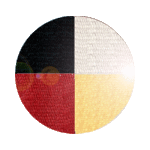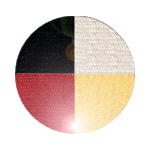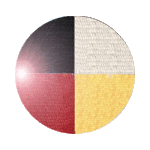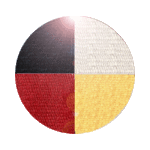The Circle grounds Indigenous people in the Land and is a powerful manifestation of “the way things are” in the reality we experience. It can describe an individual day, the seasons of a year, the stages of life, the things we do, the ways we learn, and the span of ages that roll across the face of the earth. The information about the Circle on this page will be particularly important as you near the end of your weaving process.
Because the Circle is so rich with meaning, its appearance varies from people to people. The version you’ll see in these pages (and on Tapestry’s main website) is a version that’s become fairly standardized for pan-tribal use, and is also a variant often used by the Choctaw.
When working or walking your way around the Circle, you begin in the East because that’s where the sun rises. You move clockwise or sunwise from there. It must be pointed out before you begin that this particular Circle is specific to the northern hemisphere and, to some degree, the central continental areas rather than the coasts or high mountains.
 East is the place of newness and beginnings: sunrise, birth and rebirth, the spring of the year, the childhood of one’s life, an age of healing or regeneration and optimism in history. It is a direction fresh with potential, the place of a growing promise that remains fragile even as it expresses the vigor of youth. Any time you learn something new, begin a new project, or face life with renewed hope, you are in the East. The color is yellow: the light of the rising sun in a cloudless spring sky, tender grass spangled with dew underneath it and birds seeding music in the stillness between.
East is the place of newness and beginnings: sunrise, birth and rebirth, the spring of the year, the childhood of one’s life, an age of healing or regeneration and optimism in history. It is a direction fresh with potential, the place of a growing promise that remains fragile even as it expresses the vigor of youth. Any time you learn something new, begin a new project, or face life with renewed hope, you are in the East. The color is yellow: the light of the rising sun in a cloudless spring sky, tender grass spangled with dew underneath it and birds seeding music in the stillness between.
 Summer rides up on warm winds from the south during the months when the corn ripens. This is the time of fertility, maturity, and productivity. It’s warm afternoons of gathering blackberries, the long green swath of summer lushness rising in grass and leaves so slick they shine, the mature years of men and women who have settled to their lives’ tasks and to homes and families and being part of a healthy community. The color is red because red earth and life’s blood both pulse with the fertile creative force of the living Land.
Summer rides up on warm winds from the south during the months when the corn ripens. This is the time of fertility, maturity, and productivity. It’s warm afternoons of gathering blackberries, the long green swath of summer lushness rising in grass and leaves so slick they shine, the mature years of men and women who have settled to their lives’ tasks and to homes and families and being part of a healthy community. The color is red because red earth and life’s blood both pulse with the fertile creative force of the living Land.
 In the west, thunderheads tower blindingly white into skies blue as sapphire. Their bases spread into wide sheets dark as slate and lightning flickers restlessly in the stillness. Then come rain and hail, strong winds, and sometimes tornadoes. The violence of thunderstorms may damage, but the rain they bring fills the rivers and makes the land bloom. This paradox reminds us that our lives depend utterly on things immeasurably larger than ourselves and far beyond our control. The bases of the thunderheads give this direction its color: black.
In the west, thunderheads tower blindingly white into skies blue as sapphire. Their bases spread into wide sheets dark as slate and lightning flickers restlessly in the stillness. Then come rain and hail, strong winds, and sometimes tornadoes. The violence of thunderstorms may damage, but the rain they bring fills the rivers and makes the land bloom. This paradox reminds us that our lives depend utterly on things immeasurably larger than ourselves and far beyond our control. The bases of the thunderheads give this direction its color: black.
 Winter’s north winds bring snow and deep silence to the land. Some creatures burrow down beneath the frost and sleep, others migrate south. Grasses die and wither, and hardwood trees drop their leaves and go dormant. These are times of deep quiet, of rest and renewal, of death in which new life stirs unseen — seeds in frozen ground beneath the snow. In this silence, stories grow like flames of a warming fire and are shared from person to person as they gather indoors. Dreams fall like flakes of snow onto the shelter over a human heart. The color is white.
Winter’s north winds bring snow and deep silence to the land. Some creatures burrow down beneath the frost and sleep, others migrate south. Grasses die and wither, and hardwood trees drop their leaves and go dormant. These are times of deep quiet, of rest and renewal, of death in which new life stirs unseen — seeds in frozen ground beneath the snow. In this silence, stories grow like flames of a warming fire and are shared from person to person as they gather indoors. Dreams fall like flakes of snow onto the shelter over a human heart. The color is white.
Everything is connected in the Center, the heart of the living earth. The dynamic, creative nature of the Center is expressed by the verbs that explain its structure: the crosspieces of axes and cardinal directions come together, and when they do this, they create the Circle between them. So the Circle is the land itself. The Center of that Circle is the place where everything comes together, and also — simultaneously — the place where new things emerge.
Click here to return to the list of pages at Weaving the Basket.
Click here for list of References.

